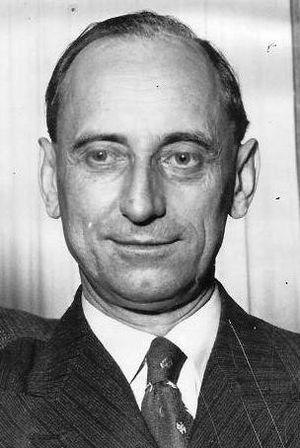Santiago Casares Quiroga facts for kids
Quick facts for kids
The Most Excellent
Santiago Casares Quiroga
|
|
|---|---|
 |
|
| Prime Minister of Spain | |
| In office 13 May 1936 – 19 July 1936 |
|
| President | Manuel Azaña |
| Preceded by | Augusto Barcia Trelles |
| Succeeded by | Diego Martínez Barrio |
| Personal details | |
| Born | 8 May 1884 A Coruña, Spain |
| Died | 17 February 1950 (aged 65) Paris, France |
| Political party | ORGA Republican Left |
| Spouse | Gloria Pérez |
| Children | María Casares |
| Occupation | Lawyer |
Santiago Casares Quiroga was an important Spanish politician. He was born on May 8, 1884, in A Coruña, Galicia, Spain. He passed away on February 17, 1950, in Paris, France. Santiago Casares Quiroga served as the Prime Minister of Spain for a short time in 1936.
Contents
Early Life and Political Beginnings
Santiago Casares Quiroga was a lawyer by profession. He became a leader and founder of a political party called the Autonomous Galician Republican Organization (ORGA). This party focused on the region of Galicia in Spain.
In 1930, he joined other important political groups in something called the Pact of San Sebastián. Their goal was to end the rule of King Alfonso XIII and create a republic in Spain. He represented a group of Galician parties working together for this change.
In December 1930, he was sent on a secret mission to Jaca. He was supposed to stop a military uprising from happening too early. However, he did not arrive in time to stop the uprising. The Jaca uprising happened on December 12, 1930, but it was not successful. Because of this, Casares Quiroga was put in prison.
Role in the Second Spanish Republic
When the Second Spanish Republic was declared in April 1931, Casares Quiroga became a government minister. He was first named the Minister of the Navy. Later, he became the Minister of Governance, which is like the Minister of Interior.
He was elected as a deputy, which is like a member of parliament, for his ORGA party. He continued to serve as Minister of Governance from 1931 to 1933. During this time, he worked in the government led by Manuel Azaña, who was a close friend.
Rise to Prime Minister
Casares Quiroga was reelected to the parliament in 1933. In 1934, his party joined with Azaña's party and others. Together, they formed a new party called the Republican Left. This party later became part of a larger group called the Popular Front.
He was reelected again in February 1936 and became the Minister of Public Works. In May 1936, his friend Manuel Azaña became the President of the Republic. On May 10, Casares Quiroga became the 132nd Prime Minister of Spain. He also served as the Minister of War.
As Prime Minister, he helped organize a special vote for Galicia. This vote was about giving Galicia more self-rule, similar to what Catalonia and the Basque Country had. The people approved this plan on June 28, 1936.
Challenges and Later Life
Casares Quiroga was still Prime Minister when a military uprising began on July 17, 1936. This event soon led to the Spanish Civil War. Facing this very difficult situation, Casares Quiroga resigned on July 19.
He was replaced by Diego Martínez Barrio, and then by José Giral. After his resignation, he did not hold any other government positions during the Civil War. He left Spain for France with Azaña and Martínez Barrio after Catalonia fell.
Santiago Casares Quiroga died in exile in Paris in 1950. He was the father of the famous actress María Casares. He was also known for being an atheist.
See also
 In Spanish: Santiago Casares Quiroga para niños
In Spanish: Santiago Casares Quiroga para niños

